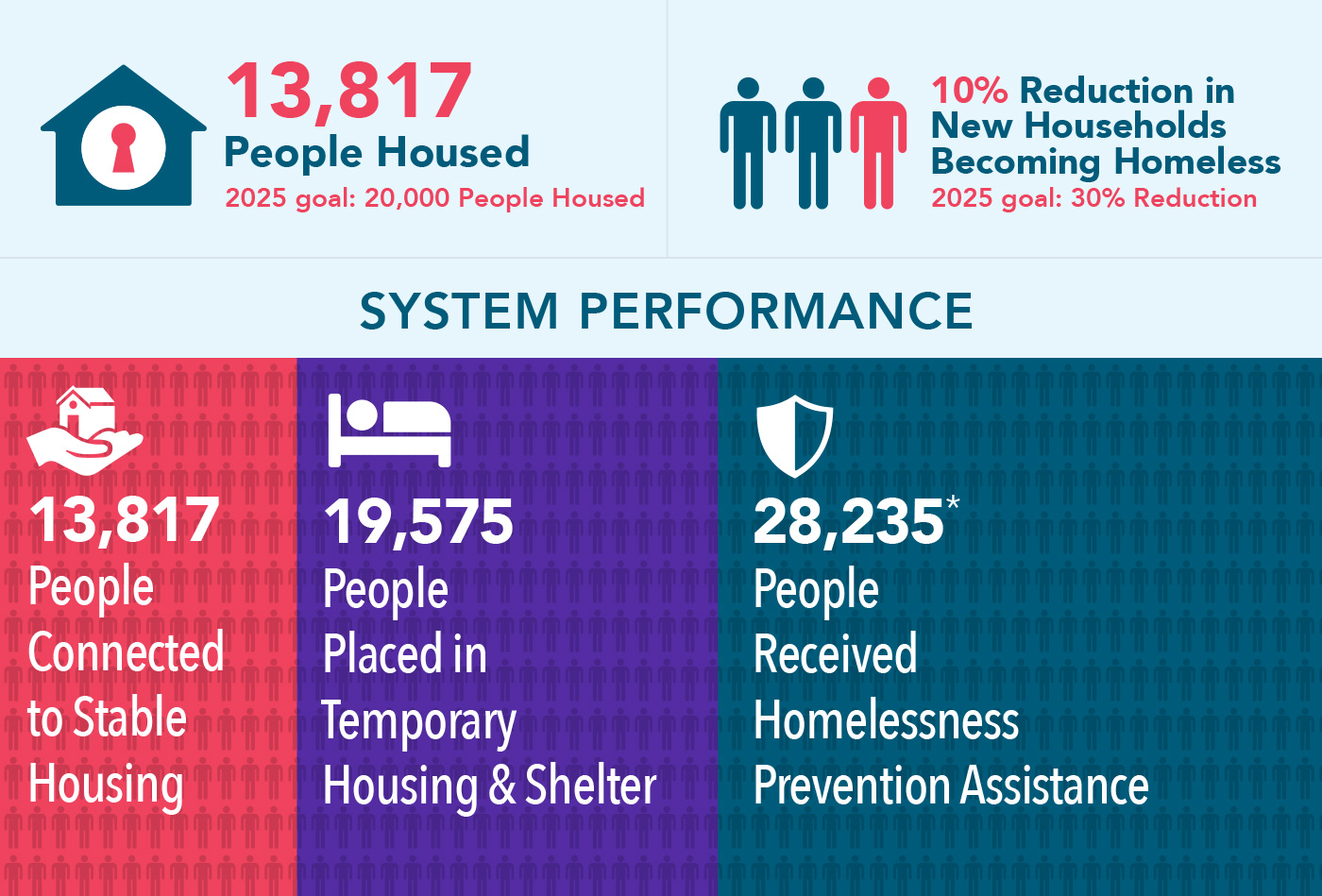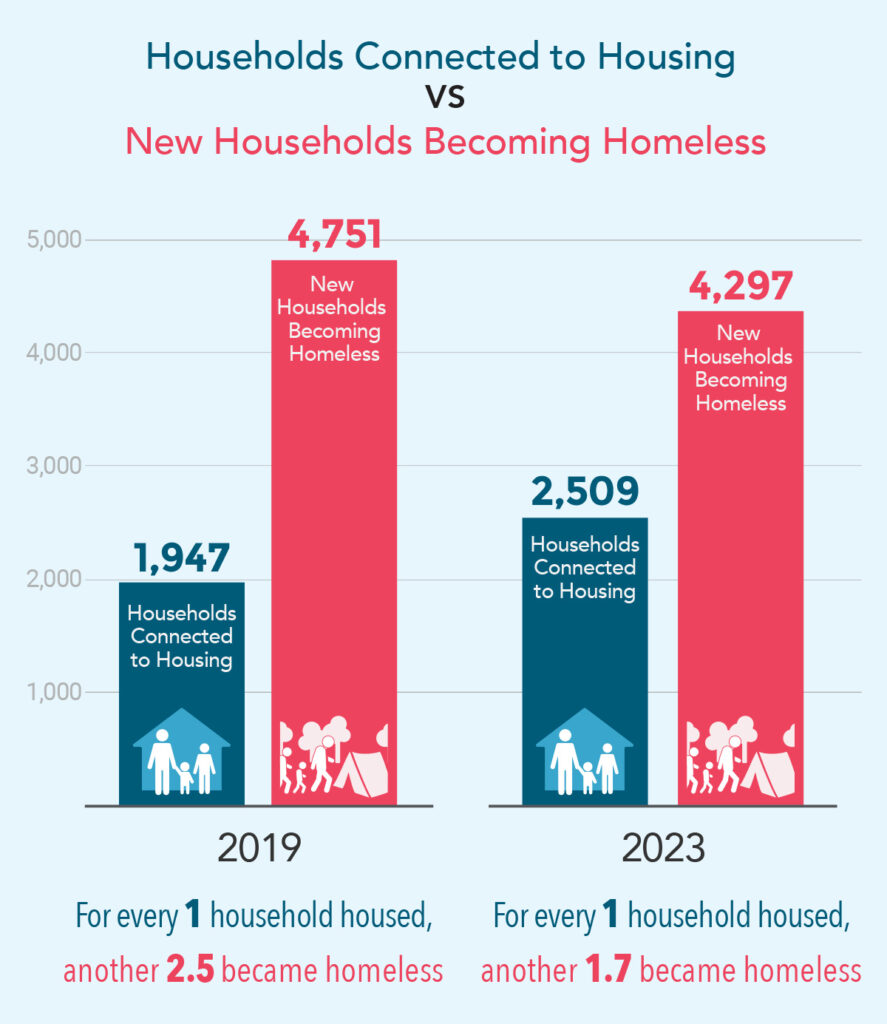Testing the Model
Confronting the COVID-19 Pandemic
The coalition was put to the test in early 2020 when COVID-19 started spreading throughout Santa Clara County. The pandemic placed individuals who were homeless or at risk of homelessness in an even more precarious situation. In addition to the public health concerns related to people living in crowded shelters or on the streets, the economic impacts of COVID-19 on those living paycheck to paycheck threatened to push even more people into homelessness.
Financial Assistance for At-Risk Households
In March 2020, the coalition quickly mobilized a countywide response to prevent the thousands of low-income households whose family members lost jobs or were put on furlough from being pushed out of their homes. Led by Destination: Home, the region pioneered the nation’s first COVID rental assistance fund, raising an initial $12 million in critical financial aid in the first few weeks of the pandemic. Within three days, however, they received thousands of calls for assistance and the initial funding was exhausted.
Additional financial aid was necessary, and Destination: Home worked with a group of elected leaders and private sector partners to raise additional funding to bridge the gap. Over the next year-and-a-half, they secured tens-of-millions of dollars in funding from roughly four dozen public, private and philanthropic donors, including an additional $10 million in funding from Cisco.
Since the Homelessness Prevention System only had the capacity to serve about 1,500 individuals per year, Destination: Home and Sacred Heart Community Service brought together a coalition of more than 70 organizations already working in underserved neighborhoods to help distribute funding more quickly and reach communities where it was most needed.
“We ended up with a pretty low transmission rate among our homeless population, which was unlike other places—because it was such a coordinated, fast effort. ”
Jen Loving, CEO, Destination: Home
The City of San Jose and County of Santa Clara Counties also adopted the nation’s first eviction moratorium to help keep people in their homes, and would later allocate tens of millions of dollars in additional federal relief funds into this effort.
This comprehensive, collaborative endeavor delivered more than $85 million in rental and financial assistance to 19,695 low-income households during the pandemic—of which 82% were extremely low income, 64% were families with children, and 94% were people of color. One-third of the funding went into five of the most highly-impacted East San Jose zip codes
Assisting Homeless Residents During the Pandemic
At the same time as they were coordinating a robust financial assistance program, the coalition was also mobilizing to meet the needs of unsheltered individuals during the pandemic.
The County of Santa Clara and the City of San Jose established emergency field offices and committed to closely coordinate their homelessness responses. The County of Santa Clara took the lead on leasing 13 hotels/motels across 8 cities, while the City of San Jose led the charge to stand up new temporary non-congregate facilities. They also jointly convened all non-profit shelter providers throughout the county, meeting twice per week to coordinate and troubleshoot problems, and collaborated on a centralized shelter hotline and referral system that is still helping to coordinate temporary shelter placements post-pandemic. Overall, the system aided nearly 5,000 homeless individuals in finding appropriate shelter during the crisis.
To deal with immediate health and safety concerns, Destination: Home worked with other members of the coalition to create a supply program for service agencies, which successfully distributed more than 100,000 pieces of personal protective equipment (PPE) to shelters, outreach teams, and various other partners. Partners within the coalition also established mobile shower and sanitation services; provided tents, tarps, and other supplies for those living in encampments; and developed a small grant program to address emerging needs among nonprofit service providers.
A Testament to the Collective Impact Model
The COVID-19 crisis showcased the profound stability and effectiveness of the collaborative system that the coalition had established over the previous decade. The existing collective impactA concept first introduced in the Stanford Social Innovation Review in 2011, collective impact is a framework for deep and sustained collaboration between actors from different sectors to solve a specific social problem. model—built on trust and collaboration—ensured a faster and more effective response in a time of immense crisis. In fact, in a testament to the level of trust and collaboration built between members of this coalition, the City of San Jose Housing Department and County of Santa Clara Office of Supportive HousingA type of housing unit or program that combines affordable housing with support services (for example, mental health, employment, or peer support services) that has proven successful in helping homeless individuals become and stay housed. Supportive housing programs can come in many forms, including long-term programs (i.e. Permanent Supportive Housing) and shorter-term support (i.e. Rapid Rehousing). even launched a joint, interagency operational center to coordinate their respective homelessness initiatives during the pandemic.
And even as the coalition pivoted to respond to the urgent needs brought on by the pandemic, the system continued to advance the overall goal of connecting more homeless people to permanent housing – with more than 3,200 individuals housed in 2020 during the height of the pandemic.
[insert call-out box on EHV deployment – SCCHA to help write]
Updating the Community Plan to End Homelessness
The COVID-19 pandemic underlined the need for bold action to address the root causes of homelessness and expand the system of care for people experiencing or at-risk of homelessness. Drawing on input from more than 8,000 community members—including people with lived experience—the coalition launched its 2020-2025 Community Plan to End Homelessness during the pandemic with a focus on three overarching strategies (each of which includes several different sub-strategies and tactics):
- Address the root causes of homelessness through system and policy change. Ending homelessness will require addressing the root causes of the crisis. The system we live in has created social, economic, and racial disparities and it will take monumental shifts in policies and priorities to make effective change.
- Expand homelessness prevention and housing programs to meet the need. While Strategy 1 aims to close the gaps in our social safety net and address the other systemic causes of homelessness, the community must concurrently take steps to scale housing development and programs to meet the growing level of need.
- Improve quality of life for unsheltered individuals and create healthy neighborhoods for all. To address this immediate crisis, the community must also increase investment in temporary shelter as well as public health, safety, mental health, substance abuse and other basic services to better meet the needs of people living in unsheltered conditions and build connections to housing programs and safety net services.
The 2020-2025 plan builds on successes and learnings from the previous five years, with a focus on growing and improving the collective impactA concept first introduced in the Stanford Social Innovation Review in 2011, collective impact is a framework for deep and sustained collaboration between actors from different sectors to solve a specific social problem. model built over the previous years. The new plan also set aggressive targets designed to reverse the growth in homelessness seen in Santa Clara County since 2017. These include housing 20,000 people through the supportive housingA type of housing unit or program that combines affordable housing with support services (for example, mental health, employment, or peer support services) that has proven successful in helping homeless individuals become and stay housed. Supportive housing programs can come in many forms, including long-term programs (i.e. Permanent Supportive Housing) and shorter-term support (i.e. Rapid Rehousing). system, as well as reducing the annual inflow of people becoming homeless by 30%.
By the end of 2023, the coalition had made significant progress against their new community plan goals:

And thanks to this collective effort, the coalition was beginning to narrow the gap between “inflow” and “outflow” – important steps towards their collective goal of ending homelessness in Santa Clara County.

Building New Interim Housing & Shelter Models
In addition to focusing on scaling the successful housing strategies that had been launched in the preceding decade, the new plan included a goal to double the community’s temporary housing and shelter capacity in order to help bring more people inside and serve as a path to accessing permanent housing.
As part of this effort, a number of coalition partners have explored new temporary housing and shelter models that can provide more private and dignified space than traditional congregate shelters: including efforts to use motels/hotels, tiny homes and modular units to provide temporary shelter for homeless individuals.
This has been a particular focus for the City of San Jose. Building on efforts made during the pandemic, the City has opened six interim housing sites (with a seventh under construction) that houses roughly 450 homeless individuals on any given night. The City has leveraged a wide variety of public and private sources to support this interim housing expansion, partnered with non-profit partners to operate these sites and provide services, and solicited input from the Lived Experience Advisory Board on the design and operations into these sites.
Across the county, there are now more than 700 units of interim housing, which has contributed to a 35% overall increase in the community’s temporary housing and shelter capacity. And thanks to concurrent investments in permanent housing programs, and the coalition’s ongoing efforts to integrate these interim shelter sites into the broader supportive housingA type of housing unit or program that combines affordable housing with support services (for example, mental health, employment, or peer support services) that has proven successful in helping homeless individuals become and stay housed. Supportive housing programs can come in many forms, including long-term programs (i.e. Permanent Supportive Housing) and shorter-term support (i.e. Rapid Rehousing). system, in 2022, more than half of the people served interim housing were able to find permanent housing.
Integrating a Racial Equity Lens
Early coalition efforts, unfortunately, did not include an explicit racial equity lens. But in 2020, Destination: Home partnered with SPARC (Supporting Partnerships for Anti-Racist Communities) to publish a report, Race & Homelessness in Santa Clara County, detailing the disproportionate impacts of homelessness among people of color, which found that they were dramatically more likely than their white counterparts to become homeless in the region, and that poverty alone could not explain this disparity.
This report helped catalyze growing efforts to better center racial equity in the coalition’s work and the 2020-2025 Community Plan to End Homelessness included both an explicit goal to reduce racial disparities among the homeless population and a number of intentional racial equity strategies, including:
- Center the voices of people who have lived experience of homelessness, especially people of color, in the policy and program design decisions of the supportive housingA type of housing unit or program that combines affordable housing with support services (for example, mental health, employment, or peer support services) that has proven successful in helping homeless individuals become and stay housed. Supportive housing programs can come in many forms, including long-term programs (i.e. Permanent Supportive Housing) and shorter-term support (i.e. Rapid Rehousing). system.
- Incentivize hiring of people who have lived experience of homelessness to reflect the client population— especially people of color and LGBTQI+ persons.
- Increase access to supportive housingA type of housing unit or program that combines affordable housing with support services (for example, mental health, employment, or peer support services) that has proven successful in helping homeless individuals become and stay housed. Supportive housing programs can come in many forms, including long-term programs (i.e. Permanent Supportive Housing) and shorter-term support (i.e. Rapid Rehousing). programs for people of color by addressing racial bias in the system.
- Provide trauma-informed care and racial equity/anti-racism training to all staff working with people experiencing homelessness.
- Align racial equity work in the homelessness sector with other racial equity initiatives in Santa Clara County.
Individual coalition members have also taken steps to further this work. For example, in 2022, Destination: Home launched the Andre Ellison Equity Fund was launched to support the outstanding work of organizations led by people with lived experience of homelessness and/or people of color. Thus far, the fund has granted a total of $3.95 million over a 3-year period to 11 organizations.
While there’s much more work ahead, coalition partners are committed to truly embedding a racial equity lens across the Continuum of Care.
Guaranteed Income Projects
In recent years, there has been growing interest in guaranteed income as a potential strategy for addressing the systemic inequities driving homelessness and many members of the coalition have helped spur a number of exciting guaranteed income projects in Santa Clara County.
One of these programs, the Silicon Valley Guaranteed Income Project, was launched in 2022 specifically for homeless and housing-insecure families. Led by Destination: Home, Sí Se Puede! Collective, UCSF Benioff Homelessness and Housing Initiative, Sacred Heart Community Service, Santa Clara County Office of Supportive HousingA type of housing unit or program that combines affordable housing with support services (for example, mental health, employment, or peer support services) that has proven successful in helping homeless individuals become and stay housed. Supportive housing programs can come in many forms, including long-term programs (i.e. Permanent Supportive Housing) and shorter-term support (i.e. Rapid Rehousing)., this project aims to stabilize 150 homeless and housing-insecure families in Santa Clara County by providing $1,000/month in no-strings-attached income for two years. The project also includes an intensive research and evaluation component to assess the effectiveness of guaranteed income on participants’ housing and economic stability, health and overall well-being.
While many of these programs are pilot projects still just getting underway, the data and findings will provide crucial insights that could inform strategies for addressing homelessness at the local, state, and national levels.
“People, Partnership, Power” Framework for Collective Impact
Three elements have been critical to building this successful collective impactA concept first introduced in the Stanford Social Innovation Review in 2011, collective impact is a framework for deep and sustained collaboration between actors from different sectors to solve a specific social problem. model that has dramatically improved our ability to prevent and end homelessness in Silicon Valley. These elements offer a framework that can be adapted and replicated by other organizations looking to address seemingly intractable challenges in their own communities.
For more information, read the article in Stanford Social Innovation Review: [TITLE/LINK]

